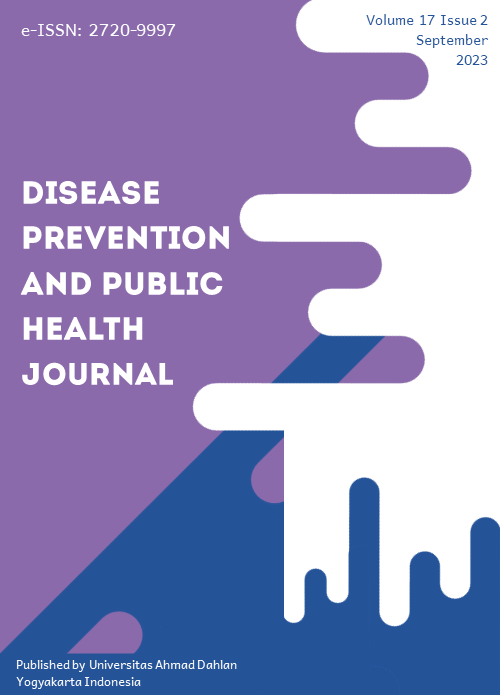Community Sanitation Risk Assessment of Tanjung Raja Village: A Rural Slum Study
DOI:
https://doi.org/10.12928/dpphj.v17i2.8165Keywords:
Sanitation Risk, Household, Rural SlumAbstract
Background: Areas with high sanitation risks have the potential to transmit infectious diseases. Meanwhile, Tanjung Raja Village is an area with a high level of slums and frequent flooding, so it has the potential to have sanitation risks. This study aimed to assess sanitation risk in Tanjung Raja village. Method: This was a quantitative study using the Environmental Sanitation Risk Assessment method. The study sample was all households in Neighborhood III of Tanjung Raja Village as many as 115 respondents using Simple Random Sampling. Results: The sanitation risk assessment of Tanjung Raja Village had a scoring category in RT 5 with high-risk results (score 3) and in RT 6 with fewer risk results (score 1) and Environmental health risks obtained related to sanitation included clean water, ownership of latrines, ownership of household waste bins, and wastewater disposal facilities. Conclusion: Tanjung Raja village has the potential to have a high sanitation risk with densely populated areas and flooded areas.
References
Hirai M, Nyamandi V, Siachema C, Shirihuru N, Dhoba L, Baggen A, Kanyowa T, Mwenda J, Dodzo L, Manangazira P, Chirume M, Overmars M, Honda Y, Chouhan A, Nzara B, Vavirai P, Sithole Z, Ngwakum P, Chitsungo S, Cronin AA. Using the Water and Sanitation for Health Facility Improvement Tool (WASH FIT) in Zimbabwe: A Cross-Sectional Study of Water, Sanitation and Hygiene Services in 50 COVID-19 Isolation Facilities. Int J Environ Res Public Health. 2021 May 25;18(11):5641. doi: 10.3390/ijerph18115641. PMID: 34070423; PMCID: PMC8197478.
Cameron L, Chase C, Suarez DC. Relationship between water and sanitation and maternal health: evidence from Indonesia. World Development. 2021;147:105637. doi: https://doi.org/10.1016/j.worlddev.2021.105637
UNICEF. Sustaining Sanitation Services During the COVID-19 Pandemic Jakarta. UNICEF. 2021 [Available from: https://www.unicef.org/indonesia/reports/sustaining-sanitation-services-during-covid-19-pandemic. doi: https://doi.org/10.3389/fenvs.2020.00098
Zakianis, Adzania FH, Fauzia S, Aryati GP, Mahkota R. Sociodemographic and environmental health risk factor of COVID-19 in Jakarta, Indonesia: An ecological study. One Health. 2021;13:100303. doi: https://doi.org/10.1016/j.onehlt.2021.100303
Diamond JB, Posey-Maddox L, Velázquez MD. Reframing suburbs: Race, place, and opportunity in suburban educational spaces. Educational Researcher. 2021;50(4):249-55. doi: https://doi.org/10.3102/0013189x20972676
Hammad HM, Ashraf M, Abbas F, Bakhat HF, Qaisrani SA, Mubeen M, et al. Environmental factors affecting the frequency of road traffic accidents: a case study of sub-urban area of Pakistan. Environmental Science and Pollution Research. 2019;26:11674-85. doi: https://doi.org/10.1007/s11356-019-04752-8
Sinaga J, Tanjung R, Mahyuni EL, Nolia H, Raflizar R. Determinants of Environmental Sanitation Related to the Incidence of Diarrhea among Infants. Disease Prevention and Public Health Journal [Internet]. 2021 Dec 6;16(1):8–15. Available from: http://dx.doi.org/10.12928/dpphj.v16i1.4384
Sahoo KC, Soni R, Kalyanasundaram M, Singh S, Parashar V, Pathak A, Purohit MR, Sabde Y, Stålsby Lundborg C, Sidney Annerstedt K, Atkins S, Rousta K, Diwan V. Dynamics of Household Waste Segregation Behaviour in Urban Community in Ujjain, India: A Framework Analysis. Int J Environ Res Public Health. 2022 Jun 15;19(12):7321. doi: 10.3390/ijerph19127321. PMID: 35742570; PMCID: PMC9224205.
Nasim N, El-Zein A, Thomas J. A review of rural and peri-urban sanitation infrastructure in South-East Asia and the Western Pacific: Highlighting regional inequalities and limited data. Int J Hyg Environ Health. 2022 Jul;244:113992. doi: 10.1016/j.ijheh.2022.113992. Epub 2022 Jun 22. PMID: 35752101.
Yaqi C, Xiao H, Xiaoning Z, Mei Q. Influence of social capital on rural household garbage sorting and recycling behavior: The moderating effect of class identity. Waste Management. 2023;158:84-92. doi: https://doi.org/10.1016/j.wasman.2022.12.036
Fatemi F, Dehdashti A, Jannati M. Implementation of Chemical Health, Safety, and Environmental Risk Assessment in Laboratories: A Case-Series Study. Front Public Health. 2022 Jun 14;10:898826. doi: 10.3389/fpubh.2022.898826. PMID: 35774572; PMCID: PMC9237427
Tseole NP, Mindu T, Kalinda C, Chimbari MJ. Barriers and facilitators to Water, Sanitation and Hygiene (WaSH) practices in Southern Africa: A scoping review. PLoS One. 2022 Aug 2;17(8):e0271726. doi: 10.1371/journal.pone.0271726. PMID: 35917339; PMCID: PMC9345477.
Wolf J, Hubbard S, Brauer M, Ambelu A, Arnold BF, Bain R, Bauza V, Brown J, Caruso BA, Clasen T, Colford JM Jr, Freeman MC, Gordon B, Johnston RB, Mertens A, Prüss-Ustün A, Ross I, Stanaway J, Zhao JT, Cumming O, Boisson S. Effectiveness of interventions to improve drinking water, sanitation, and handwashing with soap on risk of diarrhoeal disease in children in low-income and middle-income settings: a systematic review and meta-analysis. Lancet. 2022 Jul 2;400(10345):48-59. doi: 10.1016/S0140-6736(22)00937-0. Erratum in: Lancet. 2022 Jul 23;400(10348):272. Erratum in: Lancet. 2023 Jun 17;401(10393):2040. PMID: 35780792; PMCID: PMC9251635.
Afework A, Beyene H, Ermias A, Tamene A. Moving Up the Sanitation Ladder: A Study of the Coverage and Utilization of Improved Sanitation Facilities and Associated Factors Among Households in Southern Ethiopia. Environ Health Insights. 2022 Feb 24;16:11786302221080825. doi: 10.1177/11786302221080825. PMID: 35237046; PMCID: PMC8883407.
Wang D, Shen Y. Sanitation and work time: Evidence from the toilet revolution in rural China. World Development. 2022;158:105992. doi: https://doi.org/10.1016/j.worlddev.2022.105992
Cairncross S. Sanitation in the developing world: current status and future solutions. Int J Environ Health Res. 2003 Jun;13 Suppl 1:S123-31. doi: 10.1080/0960312031000102886. PMID: 12775388.
Ardillah Y, Sari IP, Windusari Y, editors. Association of Environmental Residential Sanitation Factors to Communicable Disease Risk Among Musi Side-River Household in Palembang, Indonesia: A Study of Slum Area. 2nd Sriwijaya International Conference of Public Health (SICPH 2019); 2020: Atlantis Press. doi: https://doi.org/10.2991/ahsr.k.200612.021
Yan R, Cheng S, Chen J, Li X, Sharma S, Nazim Uddin SM, et al. Operating status of public toilets in the Hutong neighborhoods of Beijing: An empirical study. Journal of Environmental Management. 2021;287:112252. doi: https://doi.org/10.1016/j.jenvman.2021.112252
Sohag MU, Podder AK. Smart garbage management system for a sustainable urban life: An IoT based application. Internet of Things. 2020;11:100255. doi: https://doi.org/10.1016/j.iot.2020.100255
Jain A, Fernald LCH, Smith KR, Subramanian SV. Sanitation in Rural India: Exploring the Associations between Dwelling Space and Household Latrine Ownership. Int J Environ Res Public Health. 2019 Feb 28;16(5):734. doi: 10.3390/ijerph16050734. PMID: 30823504; PMCID: PMC6427193.
Lopez VK, West BT, Clarke PJ, Quentin E, Eisenberg JNS. Latent variable modeling to develop a robust proxy for sensitive behaviors: application to latrine use behavior and its association with sanitation access in a middle-income country. BMC Public Health. 2019 Jan 19;19(1):90. doi: 10.1186/s12889-018-6373-x. PMID: 30660198; PMCID: PMC6339309.
Khalid HS, Ali HS, Almashhadany DA. Metalliferous content of drinking water and sediments in storage tanks of some schools in Erbil city, Iraq. Ital J Food Saf. 2020 Nov 19;9(3):8862. doi: 10.4081/ijfs.2020.8862. PMID: 33282758; PMCID: PMC7706356.
Nolt D, O'Leary ST, Aucott SW. Risks of Infectious Diseases in Newborns Exposed to Alternative Perinatal Practices. Pediatrics. 2022 Feb 1;149(2):e2021055554. doi: 10.1542/peds.2021-055554. PMID: 35104357; PMCID: PMC9645715.
Ejemot-Nwadiaro RI, Ehiri JE, Arikpo D, Meremikwu MM, Critchley JA. Hand-washing promotion for preventing diarrhoea. Cochrane Database Syst Rev. 2021 Jan 6;12(1):CD004265. doi: 10.1002/14651858.CD004265.pub4. PMID: 33539552; PMCID: PMC8094449.
Spence Beaulieu MR, Hopperstad K, Dunn RR, Reiskind MH. Simplification of vector communities during suburban succession. PLoS One. 2019 May 1;14(5):e0215485. doi: 10.1371/journal.pone.0215485. PMID: 31042734; PMCID: PMC6493735.
Bhatt N, Budhathoki SS, Lucero-Prisno DEI, Shrestha G, Bhattachan M, Thapa J, Sunny AK, Upadhyaya P, Ghimire A, Pokharel PK. What motivates open defecation? A qualitative study from a rural setting in Nepal. PLoS One. 2019 Jul 1;14(7):e0219246. doi: 10.1371/journal.pone.0219246. PMID: 31260506; PMCID: PMC6602253.
Islam M, Sultana ZZ, Iqbal A, Ali M, Hossain A. Effect of in-house crowding on childhood hospital admissions for acute respiratory infection: A matched case-control study in Bangladesh. Int J Infect Dis. 2021 Apr;105:639-645. doi: 10.1016/j.ijid.2021.03.002. Epub 2021 Mar 5. PMID: 33684561.
Qazi U, Anwar S. Hand washing behavior change effect of community-based hygiene and sanitation intervention in low resource setting. J Public Health (Oxf). 2021 Jun 7;43(2):381-384. doi: 10.1093/pubmed/fdz130. PMID: 31735966.
Prüss-Ustün A, Wolf J, Bartram J, Clasen T, Cumming O, Freeman MC, Gordon B, Hunter PR, Medlicott K, Johnston R. Burden of disease from inadequate water, sanitation and hygiene for selected adverse health outcomes: An updated analysis with a focus on low- and middle-income countries. Int J Hyg Environ Health. 2019 Jun;222(5):765-777. doi: 10.1016/j.ijheh.2019.05.004. Epub 2019 May 12. PMID: 31088724; PMCID: PMC6593152.
Ramlal PS, Lin J, Buckley CA, Stenström TA, Amoah ID. An assessment of the health risks associated with shared sanitation: a case study of the community ablution blocks in Durban, South Africa. Environ Monit Assess. 2022 Feb 10;194(3):166. doi: 10.1007/s10661-022-09815-x. PMID: 35142880; PMCID: PMC9035208.
Imarhiagbe EE, Osarenotor O. Health risk and quality assessment of non-roof-harvested rainwater from an oil-producing community in Nigeria. Environ Monit Assess. 2020 Feb 7;192(3):169. doi: 10.1007/s10661-020-8102-z. PMID: 32034527.
Downloads
Published
Issue
Section
License
Copyright (c) 2023 Universitas Ahmad Dahlan

This work is licensed under a Creative Commons Attribution-ShareAlike 4.0 International License.
Authors transfer the copyright and grant the Disease Prevention and Public Health Journal right of first publication with the work simultaneously licensed under a Creative Commons Attribution License (CC BY-SA 4.0) that allows others to share (copy and redistribute the material in any medium or format) and adapt (remix, transform, and build upon the material) the work for any purpose, even commercially with an acknowledgement of the work's authorship and initial publication in Disease Prevention and Public Health Journal. Authors are able to enter into separate, additional contractual arrangements for the non-exclusive distribution of the journal's published version of the work (e.g., post it to an institutional repository or publish it in a book), with an acknowledgement of its initial publication in Disease Prevention and Public Health Journal. Authors are permitted and encouraged to post their work online (e.g., in institutional repositories or on their website) prior to and during the submission process, as it can lead to productive exchanges, as well as earlier and greater citation of published work (See The Effect of Open Access).

This work is licensed under a Creative Commons Attribution-ShareAlike 4.0 International License.







